I bought the wrong trailer once. It looked fine. The specs were decent. Price seemed fair.
But on the job? It couldn’t handle the load. The ramps bent. The floor flexed. I had to stop halfway through the haul.
If you’ve ever tried to match a trailer to heavy or awkward cargo, you know how easy it is to get it wrong.
Over the years, I’ve worked around flatbeds in real conditions—loading them, securing loads, checking clearances, and seeing which ones actually hold up.
In this guide, I’ll break down the 8 different types of flatbed trailers. You’ll see what makes them different, what they’re best used for, and what to watch out for.
By the end, you’ll know how to choose the right trailer for your cargo—so you can haul safely, legally, and without wasting time or money.
So let’s get started!
Quick Comparison Table
Before we dive deeper into each trailer type, here’s a quick side-by-side look to help you see the key differences at a glance.
| Trailer Type | Length (ft) | Deck Height | Max Payload (lbs) | Best Use | Special Features |
| Standard Flatbed | 48–53 | ~5 ft | ~48,000 | Legal-sized, stackable cargo | Most common, easy to load from any side |
| Drop Deck (Step Deck) | 48–53 | ~3.5 ft (lower) | ~45,000 | Tall equipment and machinery | Extra clearance for taller cargo |
| Extendable Flatbed | 48–80+ | ~5 ft | ~43,000–45,000 | Long, rigid cargo like beams and pipes | Sliding frame prevents rear overhang |
| Double Drop Deck | 48 (Well: 25–29) | ~18–24 in (well) | ~35,000–45,000 | Oversized and tall machines | Deep center well for extra vertical clearance |
| Removable Gooseneck (RGN) | 48–53 | ~18–24 in (well) | ~40,000–100,000+ | Heavy, self-propelled or towed machinery | Detachable front for ground-level loading |
| Conestoga Flatbed | 48–53 | ~5 ft | ~42,000–45,000 | Finished goods, weather-sensitive cargo | Sliding tarp system with full side/top access |
| Side Kit Flatbed | 48–53 | ~5 ft | ~42,000–45,000 | Bagged, loose, or fragile materials | Removable side panels with tarp support |
| Lowboy Trailer | 24–29 (Well) | ~18–24 in (well) | ~40,000–80,000+ | Extremely heavy and tall construction loads | Built for max height/weight with low deck profile |
Let’s now walk through each trailer type to see how it works in real-world hauling.
1. Standard Flatbed Trailer
I still remember hauling my first load of steel beams with a standard flatbed. It was simple, open, and got the job done—but I quickly learned that knowing the trailer’s limits matters just as much as knowing how to secure the load.
The standard flatbed is one of the most used trailers across industries. It’s flexible, easy to load, and legal in most places without extra permits. But it works best when your cargo fits the right size, weight, and shape.
Specifications
Dimensions:
- Length: 48 feet (standard), 53 feet (extended option)
- Width: 8 feet 6 inches (legal max without permit)
- Deck Height: Around 5 feet
- Max Load Height: About 8 feet 6 inches (to stay under legal overall height limit)
Weight and Capacity
- Max Payload: Around 48,000 pounds (24 tons)
- Gross Vehicle Weight Rating (GVWR): Up to 80,000 pounds (combined with tractor)
- Axle Setup: Typically tandem axles (two axles), but some use spread axles for better weight distribution
Materials
- Main Frame: High-tensile steel or aluminum
- Crossmembers: Steel crossmembers spaced 12″ to 24″ apart
- Decking:
- Wood (usually oak or apitong) for better grip and durability
- Some use composite or aluminum decking to reduce weight
- Rub Rail and Stake Pockets: Along both sides for securing loads
- Landing Gear: Two-speed crank landing legs in front
Common Cargo Types
Standard flatbeds are made for solid, heavy items. You’ll often see:
- Steel coils and rebar
- Lumber and plywood
- Precast concrete slabs
- Machinery parts
- Agricultural equipment
- Bulk bagged materials
Loading and Unloading
The biggest strength of a flatbed is open access.
You can load cargo using:
- A forklift from the side
- A crane from the top
- Ramps from the back (for drive-on equipment)
No need for a loading dock. This saves hours at job sites. I’ve delivered to gravel lots, muddy fields, and side streets—no problem.
Road Regulations and Permits
Most states allow:
- Width: Up to 8 ft 6 in
- Height (with load): Up to 13 ft 6 in
- Total weight (truck + trailer + cargo): 80,000 lbs
Go over that, and you’ll need a permit. Oversize and overweight loads often require extra paperwork or escort vehicles. Always check state DOT rules before the haul
Key Points
It’s one of the most versatile trailers—great for hauling construction materials, pallets, or equipment. But it has no roof or sides, so loads need to be well-secured and protected from weather. It also has limited clearance for tall cargo.
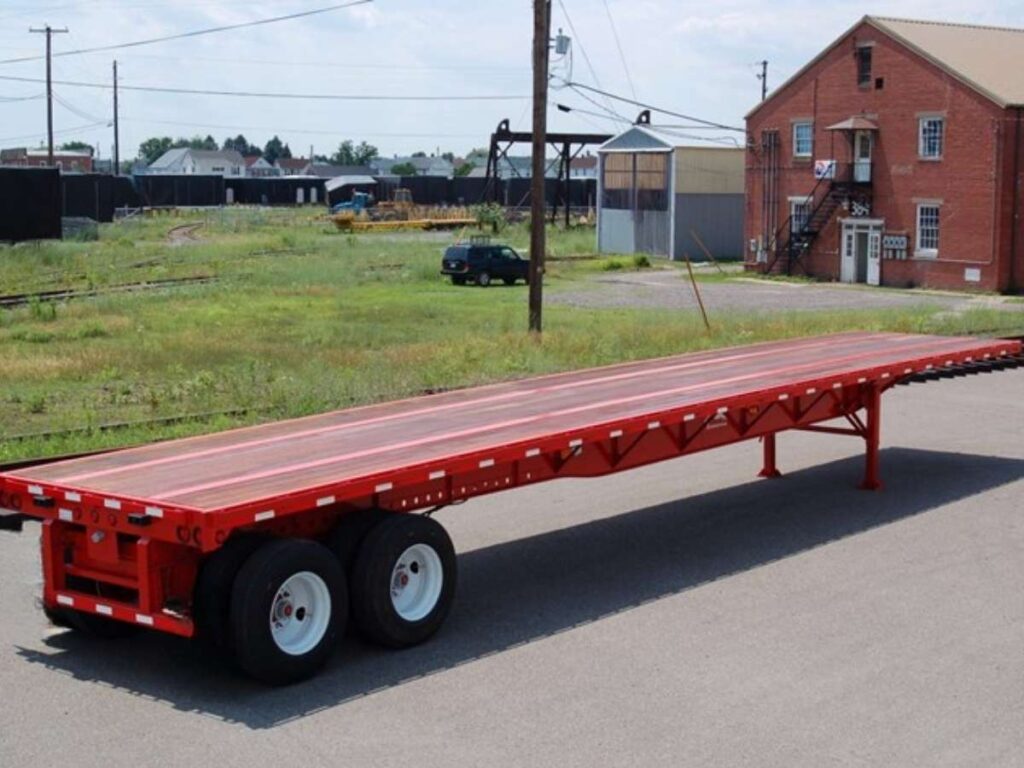
2. Drop Deck (Step Deck) Trailer
I once helped a contractor haul a large industrial tank that couldn’t legally sit on a standard flatbed—it was just too tall. We switched to a step deck, and that made all the difference. No permits. No reroutes. Just a clean, legal haul.
If you’ve got tall equipment or oversized cargo, you’ll want to look closely at a drop deck trailer. Also called a step deck, it gives you more vertical room—without needing permits in many cases.
Specifications
Dimensions
- Upper Deck Length: ~10 to 11 ft
- Lower Deck Length: ~37 to 43 ft
- Total Trailer Length: 48 ft (some extended to 53 ft)
- Width: 8 ft 6 in (standard legal max)
- Deck Heights:
- Upper Deck: ~5 ft
- Lower Deck: ~3 ft 6 in to 3 ft 9 in
- Max Cargo Height (Lower Deck): ~10 ft
Weight Capacity
- Max Payload: Around 45,000 to 48,000 lbs
- Axle Configuration: Usually tandem; spread axles are common too
- GVWR: Up to 80,000 lbs (truck + trailer + load)
Materials
- Frame: High-strength steel or aluminum
- Deck: Wood (like apitong), aluminum, or mixed
- Crossmembers: Usually steel, spaced 12″ to 24″
Common Cargo Types
- Backhoes, bulldozers, and skid steers
- Large tanks or silos
- Pallet racks and storage systems
- Modular buildings or pre-fab walls
- Steel beams too tall for a regular flatbed
Loading and Unloading
You can load a drop deck from the side, top, or rear—just like a standard flatbed.
But the difference is in the lower deck.
- Rear loading is easier because the deck is closer to the ground. Ramps don’t need to be as steep.
- Forklift loading takes more planning—the step between decks can slow you down.
- Only the upper deck matches dock height, so plan ahead if unloading at a warehouse.
Road Regulations and Permits
Drop decks let you haul taller cargo without going over legal height in most states.
- Max width: 8 ft 6 in
- Max loaded height: ~13 ft 6 in
- Over that? You’ll need a permit
Also, check bridge laws and axle spacing rules—some states are strict about rear overhang and overall length.
Key Points
This trailer gives you extra height space for tall machines or tanks and makes rear loading easier. However, only the upper deck lines up with loading docks, and uneven loads may take longer to secure. It costs more than a standard flatbed but opens up more cargo options.
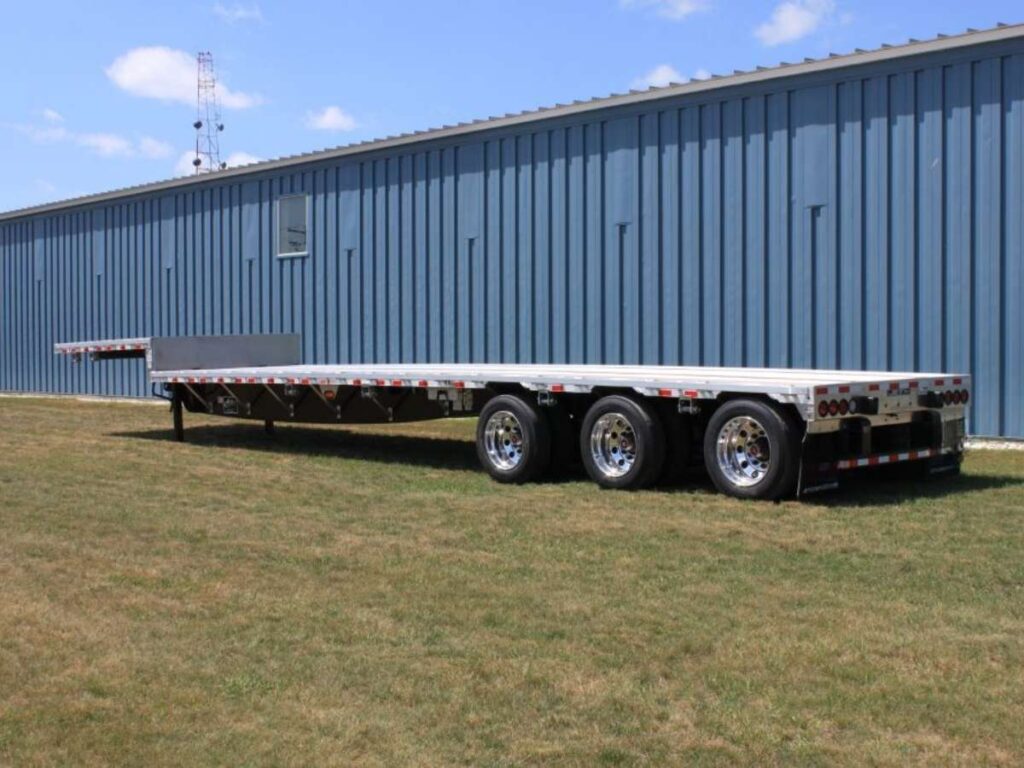
3. Extendable Flatbed Trailer
I helped a crew haul a 70-foot bridge beam that just couldn’t fit on a regular trailer. The back end hung out way too far, and it became a safety issue. Switching to an extendable trailer made the job smooth—and legal.
If you’re moving long, rigid cargo, a standard flatbed probably won’t cut it. An extendable trailer gives you the length you need without running into trouble on the road.
Specifications
Dimensions
- Collapsed Length: 48 ft (some start at 43 ft)
- Extended Length: Up to 80 ft or more
- Width: 8 ft 6 in
- Deck Height: ~5 ft (same as a standard flatbed)
Weight Capacity
- Payload: Around 43,000–45,000 lbs (varies depending on how far it’s extended)
- Axle Setup: Tandem or tri-axle
- GVWR: Up to 80,000 lbs total (combined with truck)
Materials
- Frame: Steel or steel-aluminum mix
- Decking: Hardwood or aluminum
- Crossmembers: Steel, spaced closely to support long loads
Common Cargo Types
- Bridge beams
- Wind turbine blades
- Steel pipes and girders
- Utility poles
- Modular building sections
Loading and Unloading
- Use a crane or forklift, based on cargo size and weight
- Extend the trailer before loading to avoid shifting or binding
- Secure the frame locks once it’s at the right length
- Allow extra space at the site for the trailer to fully stretch out
- Check surface level—uneven ground can make extending harder
Road Regulations and Permits
You’ll often need permits when fully extended.
- Legal max length (without permit): ~53 ft
- Extended loads require overlength permits
- Some states require flag cars or escort vehicles if you go over 75–80 ft
Also check for bridge laws and rear overhang limits
Key Points
It’s ideal for hauling long cargo like steel beams or wind components without rear overhang problems. While the extra length can make maneuvering tricky and loading takes more setup, At Rhinotrail, we build extendable flatbeds with smooth sliding systems and offer support to help you match the right trailer to your haul and route.
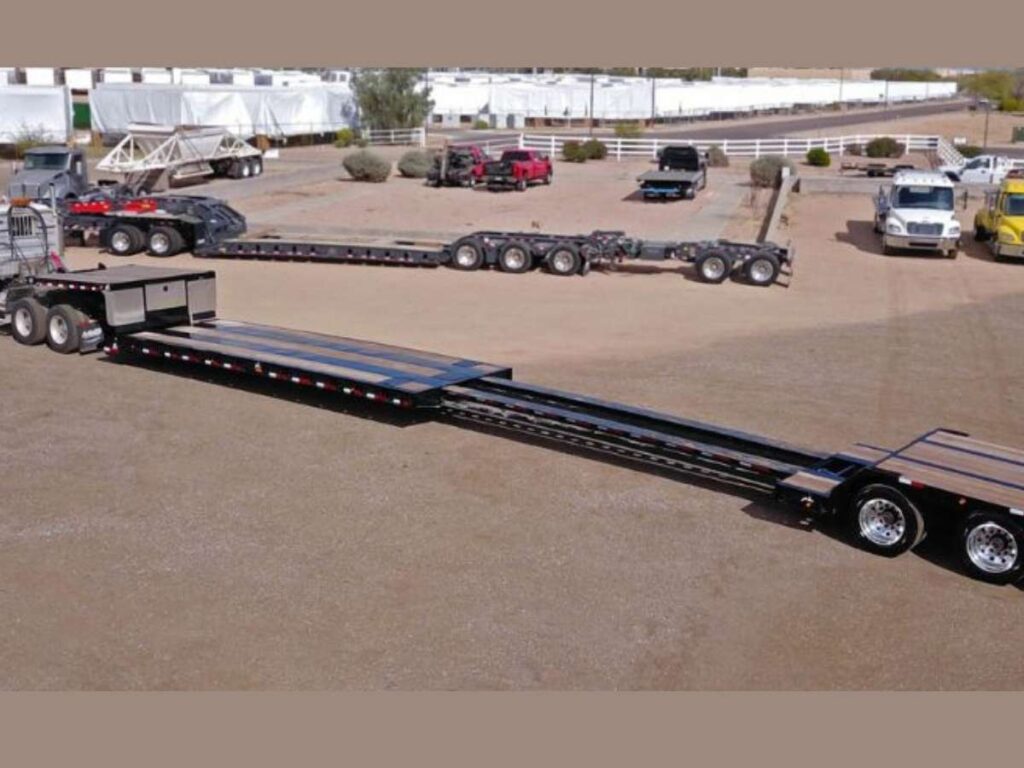
4. Double Drop Deck Trailer
I stood on a job site, watching a crawler excavator get loaded onto a double drop. The trailer’s deep center well sat low to the ground—almost level with my boots. No ramps. No struggle. Just a smooth roll-on with barely a sound.
If your cargo is tall, heavy, and impossible to split, this is the kind of trailer you turn to. The double drop is built for jobs that standard or step decks simply can’t handle.
Specifications
Dimensions
- Overall Length: 48 ft (some extendable to 53 ft)
- Width: 8 ft 6 in
- Deck Sections:
- Front Deck: ~10 ft
- Well (Center) Deck: ~25–29 ft
- Rear Deck: ~9 ft
- Well Height (Center Deck): ~18 to 24 inches
The well is where magic happens. It gives you space to haul cargo up to 11.5 ft tall, staying under the legal height limit.
Weight Capacity
- Payload: 35,000 to 45,000 lbs (can go higher with extra axles)
- Axle Setups: Often 2 or 3 axles, depending on the load
- Frame Type: Steel or steel-aluminum mix for strength and flexibility
Materials
- Frame: High-tensile steel for heavy load support
- Decking: Hardwood (often oak or apitong) or steel
- Crossmembers: Steel, spaced closely in the well area for strength
- Side Rails: Steel with stake pockets for secure tie-downs
Common Cargo Types
If it’s oversized and bulky, chances are it’s going on a double drop:
- Crawler dozers
- Excavators
- Large tanks
- Transformers
- Industrial HVAC units
- Military vehicles
Loading and Unloading
- Cargo is usually driven into the center well using ramps
- The low deck height means you don’t need steep ramps or high lifting angles
- For bulkier or fragile loads, a crane may be used
- The deep center makes loading feel more stable, especially for tracked or wheeled machines
- You’ll need extra care with weight balance due to the drop sections
Road Regulations and Permits
Even though the trailer is low, you’ll still run into limits.
- Max loaded height (legal): ~13 ft 6 in
- Max width without permit: 8 ft 6 in
- Permits are common for oversized loads, especially if you exceed height, weight, or axle limits
- Escort vehicles may be required in some states
Always check axle spacing and state rules before the haul.
Key Points
The double drop deck lets you haul tall, heavy cargo with ease and control. Its low center well makes driving on equipment feel safer and more stable. But it comes with limits—shorter deck space, higher cost, and often requires permits.
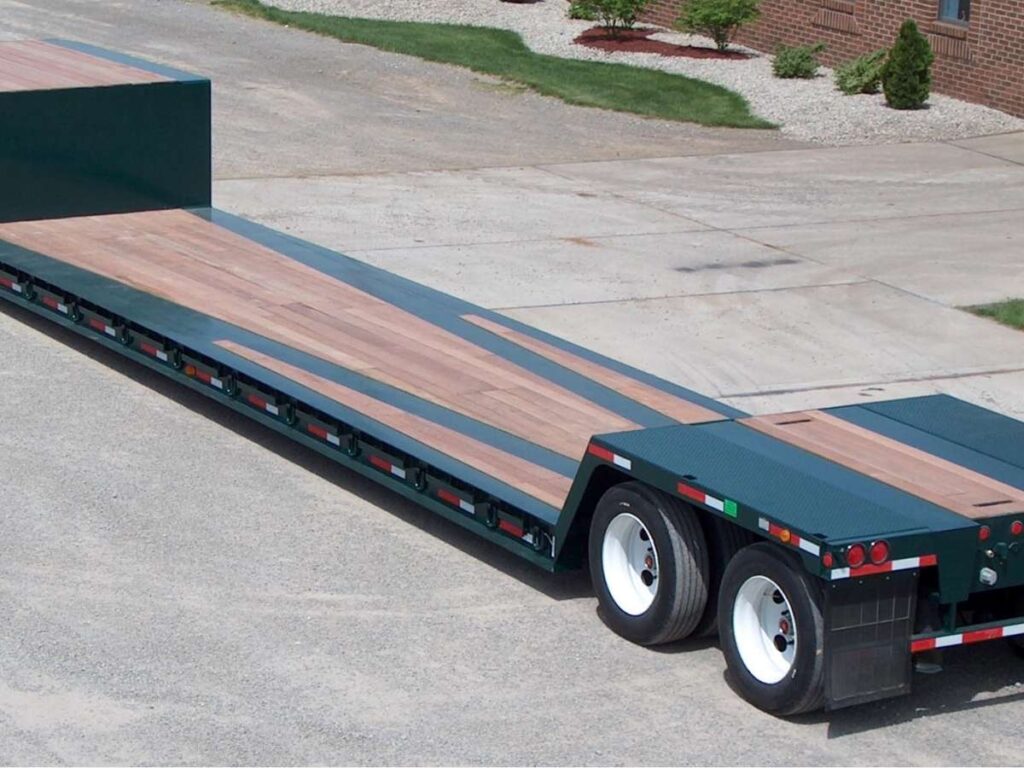
5. Removable Gooseneck Trailer (RGN)
I watched a bulldozer roll off an RGN like it was gliding down a ramp to a dirt stage. No cranes. No lifting. Just a smooth drive down to solid ground. The front of the trailer was gone—literally detached—giving the equipment its own built-in road.
If you move heavy, wheeled, or tracked machines, an RGN makes it easier—and safer. At Rhinotrail, we’ve seen how this trailer changes the game on tough jobs where other flatbeds fall short.
Specifications
Dimensions
- Standard Length: 48 ft (53 ft options available)
- Width: 8 ft 6 in
- Deck Height (Well): 18–24 inches
- Front Section: Detachable gooseneck for ground-level loading
- Deck Options: 2-axle, 3-axle, and multi-axle setups
Weight Capacity
- Payload: Starts around 40,000 lbs (can go up to 100,000+ lbs with extra axles)
- Axle Options: Modular, depending on the weight and route
- Frame: High-tensile steel with reinforced beams
Materials
- Frame: Heat-treated steel or steel-aluminum combination
- Decking: Apitong wood or steel-plated for tracked equipment
- Gooseneck: Hydraulic or mechanical, reinforced with high-strength steel
- Crossmembers: Steel, tightly spaced for heavy weight distribution
Common Cargo Types
- Bulldozers
- Excavators
- Cranes
- Drilling rigs
- Industrial generators
- Wind and energy components
Loading and Unloading
- The gooseneck detaches, dropping the front of the deck to ground level
- Machines can drive straight on or off—no ramps or lifts needed
- The low center deck makes loading feel steady and controlled
- Rear loading is rare; most use the front-drive method
- You’ll need flat, open space to safely detach and reattach the gooseneck
Road Regulations and Permits
- Height limit (loaded): Up to 13 ft 6 in
- Weight limit: Varies by axle count and state law
- Special permits: Needed for oversized or overweight hauls
- Escort vehicles: May be required for extreme loads or routes
Key Points
The RGN makes it easy to load tall, heavy equipment right from the ground—no ramps or lifting gear needed. It handles weight and clearance better than most trailers, but the setup can be complex and usually requires permits. At Rhinotrail, we help you choose the right axle configuration and support you with custom solutions that make even oversized hauls manageable.

6. Conestoga Flatbed Trailer
“There’s no way I’m tarping that in the rain,” I remember the driver saying as he looked at the load—rows of freshly painted aluminum panels. And honestly, I didn’t blame him. Tarping is slow, wet work. That’s when we rolled in with a Conestoga.
This trailer isn’t just a flatbed—it’s a flatbed with a sliding tarp system, kind of like a curtain on rails. You get full side, top, and rear protection without ever throwing a tarp. If you’ve ever fought with bungee cords in 30 mph wind, this trailer feels like a gift.
Specifications
Dimensions
- Length: 48 to 53 ft
- Width: 8 ft 6 in
- Height (inside tarp): Varies, often ~8 ft 2 in
- Tarp System: Sliding frame with retractable curtain sides
Weight Capacity
- Payload: Around 42,000–45,000 lbs
- Slightly lower than standard flatbeds due to added weight from the tarp frame
- Best for medium to heavy loads that need surface protection
Materials
- Frame: Steel or aluminum
- Decking: Hardwood (usually oak) or aluminum planks
- Curtain System: Vinyl tarp on a steel or aluminum sliding frame
- Crossmembers: Steel, typically 12″ to 24″ apart for load support
Common Cargo Types
If the surface of your cargo matters, or it needs to stay dry, this trailer makes sense:
- Painted metal and finished steel
- Machinery with sensitive electronics
- Crated goods or packaged units
- High-end lumber or architectural materials
- Aerospace or automotive components
Loading and Unloading
- The tarp system slides all the way to the front or back
- You can load from the side, top, or rear just like a standard flatbed
- Once loaded, the curtain closes in minutes—no tarps, no ropes, no ladder climbs
- Works well at docks, yards, or construction sites
When you’re racing daylight or dodging rain, you’ll appreciate how fast and clean the whole process feels.
Road Regulations and Permits
- Width: 8 ft 6 in
- Height (with tarp closed): Must stay under 13 ft 6 in total
- Weight: Under 80,000 lbs combined
- No special permits needed unless the load itself is oversized
Key Points
The Conestoga flatbed protects your cargo like a dry van but loads like a flatbed—no tarping needed. It’s heavier and more expensive than a standard trailer, which means slightly lower payload and higher upfront cost.
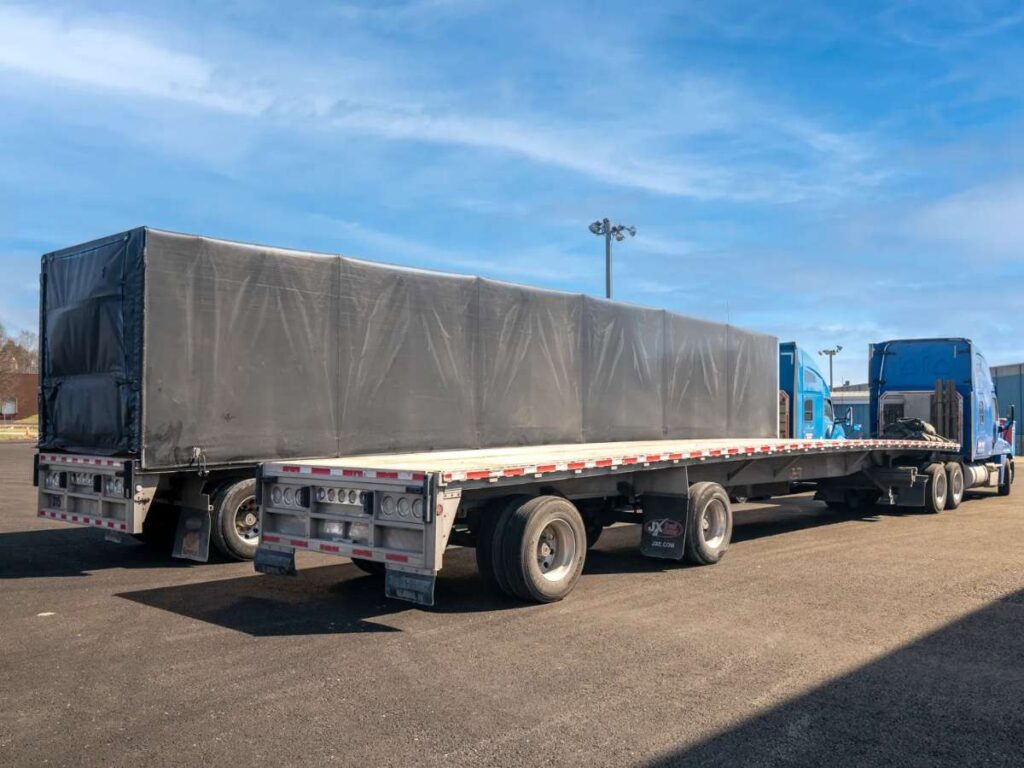
7. Side Kit Flatbed Trailer
We were loading bagged fertilizer one morning. Wind picked up. Pallets started leaning. The customer said, “You sure this won’t shift on the road?” I looked at the side panels already locked in place and replied, “That’s why we’re using a side kit.”
Side kit trailers give you structure—removable walls, bows, and tarp support—on top of a regular flatbed. If your load needs more control without switching to a van, this is the solution.
Specifications
Dimensions
- Length: 48 to 53 ft
- Width: 8 ft 6 in
- Interior Height: ~8 to 8.5 ft (under tarp)
- Structure: Steel or aluminum side posts, plywood or fiberglass panels, curved tarp bows
You can remove the kit entirely, converting it back to an open deck when needed.
Weight Capacity
- Payload: 42,000–45,000 lbs (slightly reduced from standard due to added frame weight)
- Good for medium-weight, loose, or irregular loads
- Designed to balance protection and flexibility
Materials
- Frame: Steel or steel-aluminum hybrid
- Decking: Hardwood (oak/apitong)
- Side Panels: Fiberglass or plywood
- Bows and Posts: Galvanized steel or aluminum
- Tarp: Heavy-duty vinyl
Common Cargo Types
Side kits are often used for:
- Bagged grain, seed, or mulch
- Steel coils and wire spools
- Palletized building materials
- Agricultural or industrial bulk freight
- Weather-sensitive loads that can’t be boxed
Loading and Unloading
- Load from the rear or remove side panels for forklift access
- Some setups allow partial side opening
- Once loaded, you throw the tarp over the bows and secure it
- Faster than full tarping—especially for oddly shaped cargo
Road Regulations and Permits
Same as standard flatbeds:
- Width: 8 ft 6 in
- Height (tarped): Must stay below 13 ft 6 in
- Weight (gross): Up to 80,000 lbs
Oversize permits only apply if your load exceeds those limits
Key Points
The side kit flatbed adds removable walls and overhead cover to an open trailer—ideal for loose, fragile, or bagged freight. You lose a little payload and spend more time loading than with an open deck, but the added control is worth it when cargo needs to stay contained and dry.

8. Lowboy Trailer
If you’ve ever stood in front of a massive piece of equipment and thought, “How am I supposed to move that?”—you’re not alone. That’s exactly when a lowboy trailer comes in.
This trailer gives you something others don’t: extra-low ground clearance. That means you can haul taller, heavier machines without breaking height limits—and without the stress of constant permit chasing.
Specifications
Dimensions
- Length: 24–29 ft in the well (total length can reach 48 ft+)
- Width: 8 ft 6 in
- Deck Height (Well): ~18 to 24 inches
- Max Load Height: Up to 11.5 ft (before hitting legal limits)
The “well” is the drop-center part of the trailer—this is where your tallest equipment sits.
Weight Capacity
- Payload: Starts at 40,000 lbs
- Can go up to 80,000+ lbs with additional axles
- Built for extreme weight and height—think bulldozers, cranes, or paving machines
Materials
- Frame: Welded steel, built for extreme weight
- Decking: Apitong or oak wood, sometimes steel over wood
- Gooseneck and Ramps: Steel, often reinforced for heavy use
- Crossmembers: Heavy-duty steel, spaced close together in the well
Common Cargo Types
If you’re moving something heavy, wide, or oversized, the lowboy is your go-to.
- Large construction machines
- Excavators and bulldozers
- Pavers, rollers, and milling machines
- Drilling equipment
- Oilfield and energy units
Loading and Unloading
- Equipment is usually driven on using rear ramps
- Some trailers allow detach-at-front loading for extra access
- The lower deck gives you less incline, so it’s easier and safer to load
- It’s built for tracked and wheeled machines that can handle rough surfaces
Road Regulations and Permits
You’ll need permits more often here.
- Max legal loaded height: ~13 ft 6 in
- Max width: 8 ft 6 in
- Weight: Up to 80,000 lbs (more with extra axles)
- Overdimension loads = route planning + permits + possible escorts
Know your route and your load specs—permits are part of the job.
Key Points
The lowboy trailer lets you move extremely heavy, tall cargo without disassembly. It’s the right choice when your machines won’t fit on a standard or step deck. You’ll need permits and planning—but if you’re hauling big iron, this trailer does the heavy lifting.
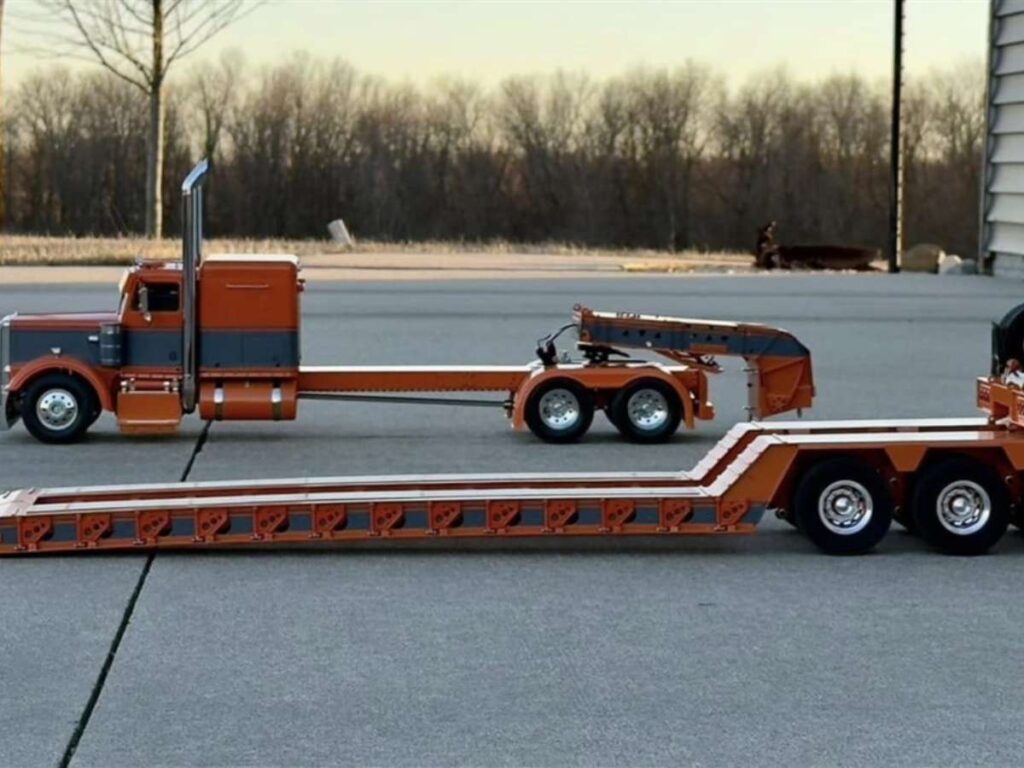
Conclusion
Choosing a trailer doesn’t have to be confusing. Now you’ve seen what makes each type different—length, height, weight, access, and more.
We started this article with a real job that went wrong. But we ended with the tools to do it right.
Whatever you’re hauling, there’s a trailer that fits. The key is knowing when and why to choose it.
So, what challenge are you trying to solve today?
Contact us today. So that we help you haul smarter.


